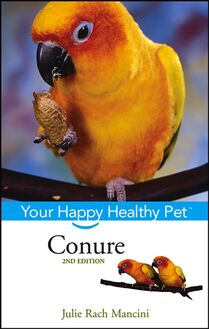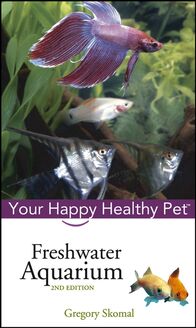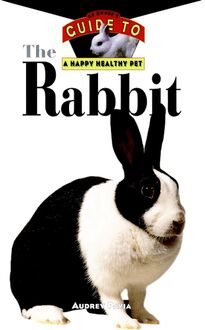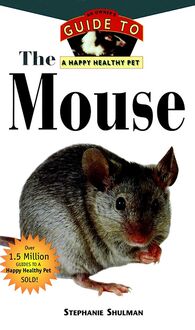-
 Univers
Univers
-
 Ebooks
Ebooks
-
 Livres audio
Livres audio
-
 Presse
Presse
-
 Podcasts
Podcasts
-
 BD
BD
-
 Documents
Documents
-
- Cours
- Révisions
- Ressources pédagogiques
- Sciences de l’éducation
- Manuels scolaires
- Langues
- Travaux de classe
- Annales de BEP
- Etudes supérieures
- Maternelle et primaire
- Fiches de lecture
- Orientation scolaire
- Méthodologie
- Corrigés de devoir
- Annales d’examens et concours
- Annales du bac
- Annales du brevet
- Rapports de stage
La lecture à portée de main
Vous pourrez modifier la taille du texte de cet ouvrage
Découvre YouScribe en t'inscrivant gratuitement
Je m'inscrisDécouvre YouScribe en t'inscrivant gratuitement
Je m'inscrisEn savoir plus
Vous pourrez modifier la taille du texte de cet ouvrage
En savoir plus

Description
- feeding
- housing
- grooming
- health care
- what to expect from the pet
- basic training
PART ONE: Welcome to the World of the African Grey.
1. The African Grey's Ancestry.
2. African Greys as Pets.
PART TWO: Living with an African Grey.
3. Caring for Your African Grey.
4. Bringing Your African Grey Home.
5. Feeding Your African Grey.
6. Grooming Your African Grey.
7. Your African Grey's Health.
PART THREE: Enjoying Your African Grey.
8. Understanding Your African Grey's Behavior.
9. Your Amazing African Grey.
PART FOUR: Beyond the Basics.
10. Resources.
Sujets
Informations
| Publié par | Turner Publishing Company |
| Date de parution | 05 mai 2008 |
| Nombre de lectures | 0 |
| EAN13 | 9780470369777 |
| Langue | English |
| Poids de l'ouvrage | 2 Mo |
Informations légales : prix de location à la page 0,0650€. Cette information est donnée uniquement à titre indicatif conformément à la législation en vigueur.
Extrait
The
African Grey
Howell Book House
Howell Book House A Simon Schuster Macmillan Company 1633 Broadway New York, NY 10019
Macmillan Publishing books may be purchased for business or sales promotional use. For information please write: Special Markets Department, Macmillan Publishing USA, 1633 Broadway, New York, NY 10019.
Copyright © 1998 by Howell Book House
All rights reserved. No pan of this book may be reproduced or transmitted in any form or by any means, electronic or mechanical, including photocopying, recording or by any information storage or retrieval system, without permission in writing from the Publisher.
MACMILLAN is a registered trademark of Macmillan, Inc. Library of Congress Cataloging-in-Publication Data Rach, Julie. The African Grey / by Julie Rach. p. cm.—(An owner’s guide to a happy healthy pet)
ISBN 0-87605-443-2
1. African grey parrot I. Title. II. Series. SF473.P3R324 1998 636.6’865—dc21 97-31329 CIP
Manufactured in the United States of America 10 9 8 7 6 5 4 3 2
Series Director: Amanda Pisani Series Assistant Director: Jennifer Liberts Book Design: Michele Laseau Cover Design: Iris Jeromnimon Illustration: Laura Robbins Photography:
Front cover photo by Eric Ilasenko; back cover photo by Mary Bloom
Joan Balzarini: 16, 20, 72, 104, 108, 119, 120, 125
Mary Bloom: 46, 49, 65, 69, 98, 102
Eric Ilasenko: Title page, 2–3, 5, 11, 17, 24, 29, 31, 33, 35, 39, 44, 55, 56, 60, 63, 64, 73, 76, 82, 100–101, 103, 105, 107, 114, 116, 118, 122
Julie Rach: 26, 27, 40, 48, 52, 110
David Schilling: 10, 13, 38, 66
Faith Uridel: 12, 51
B. Everett Webb: 7, 8, 19, 22–23, 25, 37, 43, 57, 59, 61, 74
Production Team: Stephanie Hammett, Natalie Hollifield, Clint Lahnen, Dennis Sheehan, Terri Sheehan, Chris Van Camp
Contents
part one
Welcome to the World of the African Grey
1 The African Grey’s Ancestry
2 African Greys as Pets
part two
Living with an African Grey
3 Caring for Your African Grey
4 Bringing Your African Grey Home
5 Feeding Your African Grey
6 Grooming Your African Grey
7 Your African Grey’s Health
part three
Enjoying Your African Grey
8 Understanding Your African Grey’s Behavior
9 Your Amazing African Grey
part four
Beyond the Basics
10 Resources
part one
External Features of the African Grey
chapter 1
The African Grey’s Ancestry
At this time, scientists have identified about 750 parrot species. Of this impressive number, about 280 are kept as pets, and about 250 of those have bred successfully in captivity, assuring that parrots will be around for future generations to appreciate. Since birds have been kept as pets for centuries, prospective bird owners will find themselves in good company historically.
Birdkeeping Through the Ages
The ancient Egyptians are credited with being the first to keep birds, most notably pigeons. Queen Hatsheput (1504 to 1482 B.C.) was credited as being the first monarch to create a royal zoo, which included exotic birds. The ancient Persians also knew of talking birds as early as the fifth century B.C., when a court physician and naturalist wrote about talking birds described to him by Indian merchants.
C LASSICAL G REECE AND R OME
From Egypt, birdkeeping spread to Greece and Rome. Some historians credit Alexander the Great with discovering the Alexandrian parakeet, and the Greeks receive credit for popularizing parrot-keeping outside the birds’ native lands of Africa and Asia. In the first century A.D., Pliny the Elder taught parrot training and suggested that each bird be housed in a darkened room to help it learn to speak.
Wealthy Romans built elaborate garden aviaries, and they also used mockingbirds in the entryways of their homes as feathered doorbells to announce visitors. The Romans are thought to be the first bird dealers, bringing different types of birds to Great Britain and the European continent.
E UROPE
Although birdkeeping was still largely an upper-class fancy, the Renaissance opened it up as a hobby for the masses. Portuguese sailors introduced Europe to canaries at this time, and in the 1600s the Dutch began producing varieties of canaries for show. These birds were exported to Britain, where birdkeeping became quite popular.
Around this time, in the British penal colony of Australia, a forger named Thomas Watling first described the budgerigar’s ability to mimic human speech. This bird greeted Watling’s employer by saying, “How do you do, Dr. White?”
Birdkeeping as we know it today can be traced to its beginning in Victorian Great Britain, when bird sellers in the British Isles would offer goldfinches and larks to ship captains en route to the West Indies. These common European birds would then be traded in the islands for species found there.
Some notable bird owners of history include King Henry VIII, whose African grey was alleged to have called for help when he fell in the Thames River; Marie Antoinette, who also had an African grey parrot; Wolfgang Amadeus Mozart, who kept canaries and a pet starling; Thomas Jefferson, who made a pet of a mockingbird; Andrew Jackson, whose parrot, Polly, made life interesting at the White House; and Theodore Roosevelt, whose family kept a Hyacinth Macaw during their stay in the White House.
The African Grey’s Background
As his name implies, the African grey parrot is a gray bird that comes from Africa. Attractive gray birds with red tails were seen around 1402 in the Canary Islands. They had been imported from West Africa. To this day, African greys are found in western and central Africa, from Guinea to northern Angola. The British spelling of grey is used in connection with these birds because British sailors and explorers were among the first to bring African greys out of the jungle and make pets of them.
Greys were taken from jungles and first domesticated by British sailors and explorers.
Two subspecies have been identified: the Congo grey and the Timneh grey. Both species have featherless white faces and eyes that change color as the birds mature. Birds under six months of age have large dark eyes, while birds between six months and one year of age have light gray eyes. Year-old birds have beige eyes and birds over the age of two have eyes with yellow irises and black pupils.
T HE C ONGO G REY
The Congo grey (Psittacus erithacus) is a gray bird with a solid black beak and a bright red tail. He measures about 12 to 14 inches in length and weighs between 450 and 500 grams or about a pound. Congos reach maturity when they are about two years old and can live to be fifty.
You may hear your bird’s breeder mention a Ghana or West African subspecies. These birds aren’t a true subspecies, but rather are smaller, darker Congos that average 10 inches in length and weigh between 350 and 400 grams (about ¾ of a pound).
T HE T IMNEH G REYS
Timneh greys (Psittacus erithacus timneh) are smaller, darker birds with maroon tails and, and their black beaks have a pinkish cast. They measure about 10 inches in length and weigh about 300 grams (about 10 ounces). They reach maturity at about age two and can live fifty years.
Other than size and coloring, there’s very little difference between the two subspecies. Some people consider the Timneh to be an inferior pet, but that isn’t so at all.
The Congo grey (left) is larger with lighter coloring than the Timneh grey (right).
African greys are found in western and central Africa, from Guinea to northern Angola. The Congo, also called the Cameroon or Ghana grey, ranges from Cote d’lvoire to northern Angola, while the Timneh is found in southern Guinea and western Cote d’Ivoire. The birds live in mangrove swamps and along rivers, foraging for fruits, nuts, seeds and berries. They also raid cultivated crops.
A Swiss naturalist first described African greys in the 1500s saying, “I also have one that is ash-colored or light blue over its whole body, except on the tail alone it has red feathers, and around the eyes it is white.” African greys were first identified by naturalist Carolus Linnaeus in 1758, making them one of the first parrot species to be scientifically classified. They were introduced in England by King Henry VII in the early 1500s. King Henry’s pet grey is reported to have called out “Help! I am drowning!” when he fell into the Thames River during a royal outing.
The African grey kept by the Duchess of Richmond and Lennox, who was also the mistress of Charles II of England, was buried with her in Westminster Abbey. He can be seen there today as the oldest surviving example of avian taxidermy. Marie Antoinette received a grey as a gift, and Queen Victoria’s grey, Coco, had a vocabulary that included “God save the Queen!”
PARROT TRAITS
The African grey is a type of parrot, just like the Hyacinth Macaw or Mealy Amazon. The traits that all parrot species have in common are:
four toes—two pointing backward and two pointing forward
upper beak overhanging the lower
broad head and short neck
However, a healthy African grey measures about 11 inches to 13½ inches from head to tip of the tail, while a full-grown Scarlet Macaw can easily reach 40 inches in length.
Greys were first bred outside of Africa in 1770 when a pair were coupled in France for breeding purposes. A British pair of pet birds followed suit in the United Kingdom in 1843. This pair of birds successfully raised a single chick after the breeder fashioned a flannel nest for the hen.
G REYS IN A MERICA
The grey’s history in the United States has also gone largely unrecorded. We do know that one of the first successful breeders of African greys in the United States set up a colony breeding situation in a cow barn in 1903. When he checked on the colony three years later, the breeder reported finding sixty-seven additional birds and eleven skeletons. His initial results were met with skepticism, and he retired from parrot breeding until the 1930s, when he again began to breed greys, but under more traditional
-
 Univers
Univers
-
 Ebooks
Ebooks
-
 Livres audio
Livres audio
-
 Presse
Presse
-
 Podcasts
Podcasts
-
 BD
BD
-
 Documents
Documents
-
Jeunesse
-
Littérature
-
Ressources professionnelles
-
Santé et bien-être
-
Savoirs
-
Education
-
Loisirs et hobbies
-
Art, musique et cinéma
-
Actualité et débat de société
-
Jeunesse
-
Littérature
-
Ressources professionnelles
-
Santé et bien-être
-
Savoirs
-
Education
-
Loisirs et hobbies
-
Art, musique et cinéma
-
Actualité et débat de société
-
Actualités
-
Lifestyle
-
Presse jeunesse
-
Presse professionnelle
-
Pratique
-
Presse sportive
-
Presse internationale
-
Culture & Médias
-
Action et Aventures
-
Science-fiction et Fantasy
-
Société
-
Jeunesse
-
Littérature
-
Ressources professionnelles
-
Santé et bien-être
-
Savoirs
-
Education
-
Loisirs et hobbies
-
Art, musique et cinéma
-
Actualité et débat de société
- Cours
- Révisions
- Ressources pédagogiques
- Sciences de l’éducation
- Manuels scolaires
- Langues
- Travaux de classe
- Annales de BEP
- Etudes supérieures
- Maternelle et primaire
- Fiches de lecture
- Orientation scolaire
- Méthodologie
- Corrigés de devoir
- Annales d’examens et concours
- Annales du bac
- Annales du brevet
- Rapports de stage




















